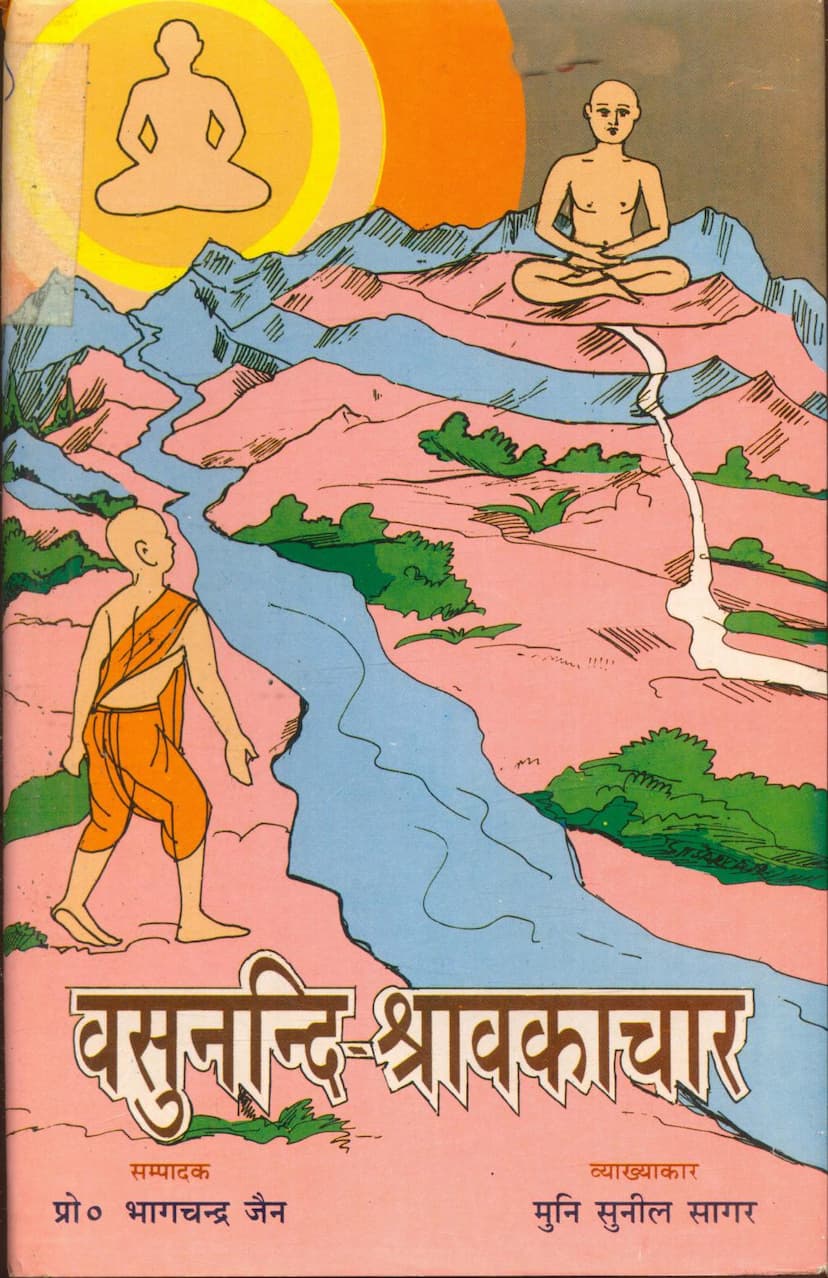Vasnunandi Shravakachar
Added to library: September 2, 2025

Summary
Here's a comprehensive summary of the Jain text "Vasnunandi Shravakachar," based on the provided pages:
Title and Author:
- Title: Vasnunandi Shravakachar (though officially named "Upasakadhyayan" by Acharya Vasunandi, it is popularly known by this name).
- Author: Acharya Vasunandi (with commentary by Muni Sunil Sagar).
- Publisher: Parshwanath Vidyapith, Varanasi.
- Language: Sauraseni (Prakrit).
- Total Verses: 546 Gathas.
Core Content:
The "Vasnunandi Shravakachar" is a significant Jain text that outlines the conduct and duties of a lay follower (Shravak). While it covers most aspects of a Shravak's life, it particularly emphasizes:
- The Seven Vices (Vyasana): The text extensively details the seven vices and the severe consequences associated with them, leading to suffering across the four states of existence (Gatis). 2A. Charitable Giving (Dana): It elaborates on the deserving recipients of charity, the giver, the item to be given, the types of donations, and their fruits.
- Vow Observances: The text describes various vratas (vows) such as Panchami, Rohini, and Ashwini vratas, outlining their rituals.
- Worship Practices: It details the six types of worship (Pujan) and the rituals for consecrating idols (Bimb-Pratishtha).
- The Eleven Vows (Pratima): The book also covers the eleven stages of a Shravak's spiritual progress, known as Pratimas.
Significance and Context:
- Connection to Scripture: The text is based on the "Upasakadhyayan," the seventh Anga of the Dwadasanga Shrut (the twelve limbs of Jain scripture), which describes the complete conduct of a Shravak. Although this Anga was lost before Acharya Vasunandi's time, he composed this work based on traditional knowledge.
- Authenticity and Style: The book is described as having a "saras, saral evam pramanik" (interesting, simple, and authentic) style.
- Publisher's Context: The publication is part of the Parshwanath Vidyapith Granthamala, highlighting its academic and religious significance. Professor Bhagchandra Jain, the editor, emphasizes the text's role in social balance and its relevance in today's environmental context.
- Commentary: Muni Sunil Sagar's commentary provides detailed explanations, interpretations, and special insights, making the text accessible to spiritual seekers.
Key Themes and Philosophical Underpinnings (from the Introduction by Prof. Bhagchandra Jain):
- Jainism as a Humanistic Religion: The introduction frames Jainism as a purely humanistic religion focused on purifying the individual for the benefit of the collective. It emphasizes self-realization leading to universal welfare and community consciousness.
- The Necessity of Religion: Religion is presented as life itself, a source of purity against worldly contamination. It awakens conscience, fosters virtues like generosity, compassion, simplicity, and humility, and promotes universal brotherhood and Sarvodaya (welfare of all).
- Critique of Religiosity: The text differentiates true religion from mere ritualism and superstition, which can lead to division, conflict, and the destruction of dharma's core essence. It warns against religious pollution and the danger of following a religion without understanding its inner spirit.
- Jainism's Emphasis on Character and Non-violence: The introduction highlights the importance of character (Charitra) and unwavering non-violence (Ahimsa) as core tenets of Jainism, which has steadfastly upheld these principles even through challenges.
- Harmony and Unity: Jainism's principles of Samata (equality), Purushartha (self-effort), and Swavalamban (self-reliance) are seen as key to societal balance. The concepts of Vibhajyavad (analysis) and Anekantavad (many-sidedness) are crucial for achieving harmony and unity.
- The Role of Shravakacharya: Shravakacharya is presented as a framework for the Shravak to integrate dharma into daily life, contributing to societal upliftment and balance.
- Jainism and the Environment: The introduction makes a strong connection between Jain principles and environmental protection, advocating for a pure lifestyle that respects all living beings and natural resources.
- Sarvodaya Philosophy: Jainism's philosophy of Sarvodaya (welfare of all), rooted in Ahimsa, Aparigraha (non-possession), and Anekantavada, is presented as a foundation for societal harmony and progress.
Structure of the Text (as indicated by the Table of Contents):
The text is structured to guide the Shravak through various aspects of their spiritual and ethical journey. The table of contents reveals a progression from foundational principles to specific practices and consequences:
- Introduction to Jainism and Society: Setting the context for the Shravak's role.
- Shravakacharya as a Life Philosophy: Defining the Shravak's way of life.
- Acharya Vasunandi and his Work: Contextualizing the author and the text.
- The Process of Editing: Information about the current edition.
- Fundamental Principles: Jain Dharma and Society, the need for Dharma, its definition, Sarvodaya, and the relationship between Shravakacharya and the environment.
- The Nature of Dharma: Exploring its general, inherent, qualitative, path-to-liberation, and social aspects.
- The Shravak's Path: From the initial stage of Darshan Shravak to the more advanced stages of Vaishik, Nishthik, and Sadhak, including the eleven Pratimas.
- Core Vows (Anuvratas) and Vices: Detailed discussion on the five Anuvratas, the seven vices (Sapt Vyasan), and their implications.
- Specific Rituals and Practices: Explanations of various vratas, the concept of Sallekhana (fasting unto death), and the historical development of practices like Ashtamoolgunas.
- Moral and Ethical Conduct: The text delves into the qualities expected of a Shravak, the importance of charity, and the types of donors and recipients.
- Consequences of Actions: Detailed descriptions of the suffering in different realms (Naraka, Tirayanch, Manual, Deva) as a result of actions, particularly related to the seven vices.
- The Importance of Purity: Emphasis on pure conduct, especially in diet (ahimsa in food) and avoiding harmful practices.
- Philosophical Concepts: Discussion on the nature of soul (Jiva), non-soul (Ajeeva), Karma, Samvara (restraint), Nirjara (shedding karma), Moksha (liberation), Gun Sthanas (stages of spiritual development), and the concept of Sarvodaya.
In essence, "Vasnunandi Shravakachar" serves as a comprehensive guide for Jain lay followers, detailing their ethical responsibilities, spiritual practices, and the cosmic consequences of their actions, all within the framework of Jain philosophy and its emphasis on Ahimsa, Aparigraha, and character development.